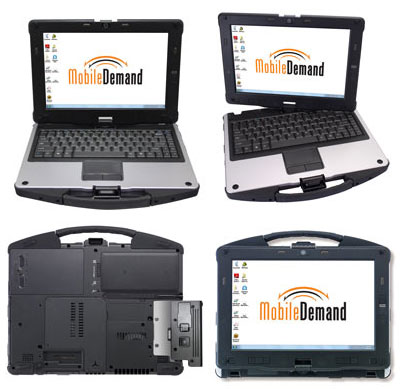|
MobileDemand xTablet C1300
Rugged convertible tablet computer gets an update to Intel 3rd generation Core processor technology
(by Conrad H. Blickenstorfer)
MobileDemand of Hiawatha, Iowa, is primarily known as the manufacturer of the xTablet family of rugged Tablet PCs, but the company's lineup also includes a rugged convertible tablet that easily transforms from a Tablet PC to a laptop, addressing the needs of mobile professionals who need laptop-class connectivity and access to business applications anytime, anywhere. The C1300, introduced in May 2013, is a technology update to the initial C1200.

As the picture sequence above shows, this type of hybrid machine combines the advantages of a tablet with those of a notebook computer. In notebook configuration the xTablet C1300 works just like a standard laptop, offering all the benefits of a full keyboard and the type of extensive connectivity notebooks commonly come with. That's good for applications that require frequent typing and rely on desktop-style applications that are best done with a conventional keyboard/touchpad/mouse setup. However, simply rotate the display around its central pivot hinge and fold it down flat on top of the keyboard, with the LCD facing up, and the C1300 becomes a tablet with all of the inherent benefits and advantages of that form factor.
But doesn't this convertible concept make the C1300 too large or heavy? That depends on how you're looking at it. As is, the new xTablet C1300 measures 12.9 x 10.9 inches, is 1.6 inches thick, and weighs as little as 5.5 pounds. That's no thicker than traditional rugged Tablet PC, and only about a pound heavier. So yes, the C1300 weighs a bit more, but for those who need the extra functionality, that's a small price to pay for a computer that's both a tablet and a notebook. In addition, the C1300's 12.1-inch display is considerably larger than that of most dedicated Windows tablets, so if screen real estate matters, that's another reason to consider the C1300.
But there's more. The design of a mobile computer is always a compromise. Pure tablets generally need to emphasize long battery life and low weight for duty in the field and far from electrical outlets, and that comes at the cost of performance, features, screen size, etc. A convertible like the xTablet C1300, on the other hand, will likely see mixed use in offices, vehicles and the field where it can be recharged and the emphasis is on convenience and performance at the cost of a bit of battery life. MobileDemand took advantage of that by not only offering the large 12-inch 1280 x 800 pixel display, but also by using a sophisticated Intel 3rd generation Core-i5 processor that provides substantial performance and access to many of Intel's latest processor technologies. The Core 1.7GHz i5-3427U used in the C1300 is an ultra low voltage design with a thermal design power of just 17 watts, but it runs at up to 2.8GHz in Turbo Boost mode, making this updated version a good bit faster than the xTablet C1200 it replaces.
Thanks to 22nm processing technology and other innovations, the third generation of Intel Core processors has lower power draw, much better integrated graphics performance in every respect, as well as native support of USB 3.0 and PCIe 3.0 via the "Panther Point" chipset. What does that mean? For one thing, though the new C1300 model will feel significantly quicker. And anyone who needed discrete graphics before may find that the 3rd gen's own graphics are more than adequate. For storage, there are a variety of shock-mounted 2.5-inch SATA 3.0 hard drives or SSDs. There's also an optional internal mSATA to support Intel Rapid Start Technology for fast resume. RAM now goes up to 16GB of DDR3.
Yet, despite the considerable performance, Mobile Demand states typical battery life as "four hours minimum." If that is not enough, there's an optional second Polymer battery that boosts battery life to eight hours and also offers hot-swapping.
The system comes with a resistive touch screen, but also supports an optional dual input panel that provides both resistive touch and an active digitizer. Optionally available is also a sunlight readble version of the display with enhanced brightness, anti-reflective properties and other optical treatments. There is a full-size spill-resistant 86-key keyboard.
The C1300 has good onboard connectivity that can be customized via adding one of four available I/O modules. Standard connectivity consists of a USB 3.0 port, a USB 2.0 port that also provides e-SATA functionality, VGA, RJ45 gigabit LAN, and a docking connector. There is also an ExpressCard 34 slot and an SDHC card reader. I/O modules can add a USB and a serial port; a USB port and a Smart card reader; HSDPA, Gobi 2000 or GPS; or a second 2-megapixel camera (the system comes with an integrated 1.3-megapixel webcam).
Integrated wireless includes 802.11b/g/n WiFi via an Intel Centrino Wireless-N 2230 PCI-e card that also provides Bluetooth version 4.0 with EDR. WWAN and/or GPS are available via the above-mentioned I/O module options.
Like all Mobile Demand tablets, the xTablet C1300 is tough and rugged. It uses a lightweight magnesium alloy case that's 20 times stronger than the commonly used ABS plastic. A spill-resistant keyboard and additional sealing protect against common accidents. The machine is drop-resistant and able to survive multiple drops from four feet. Generous anti-shock mounting protects the LCD and hard disk (the device comes standard with SSD). Ports are protected, but there is no official IP rating. Operating temperature is -4 to 122 degrees Fahrenheit, which means the C1300 can be used in virtually any environment, including commercial freezers.
RuggedPCReview has not yet benchmarked the C1300; for a full review of the predecessor C1200 model see here.
|




